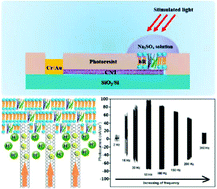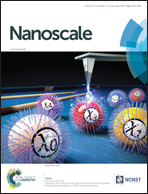A novel cell-scale bio-nanogenerator based on electron–ion interaction for fast light power conversion†
Abstract
Natural energy haversting devices serve as an alternative candidate for power supply in many micro-/nano-systems. However, traditional nanogenerators based on piezoelectricity or triboelectric power generation face challenges in terms of biocompatibility and stability in various biological systems. The bacteriorhodopsin (bR) protein in Halobacterium halobium is an ideal biocompatible material for photoelectric conversion. Conventional bR systems based on ion transport or enhanced light absorption layers have a limited light power conversion speed. On the other hand, bR-based biohybrid devices have a great potential for sensitive light power conversion as compared to conventional nanogenerators. Herein, we present a biohybrid nanogenerator made of bR and horizontally aligned-long carbon nanotubes (CNTs) with electron–ion interaction for the first time for sensitive light power conversion. The bR layer serves as the proton pump, whereas CNTs are utilized to enhance the photocurrent; thus, the photocurrent frequency response improves significantly because of the effect of the electron–ion interaction. The photocurrent shows a linear relationship with the intensity of light and can still obtain a stable signal at a light intensity of 0.03 mW cm−2. With regard to the influence of the light on–off period, the photocurrent initially increases and then decreases with an increase in flickering frequency up to 360 Hz; this can be ascribed to the combinational influence of light switch speed and photocycle decay time. The photocurrent shows highest value (99 nA cm−2) at a frequency of about 50 Hz at a light intensity of 0.43 mW cm−2, which matches well with the frequency standard of the electrical power supply system. Moreover, we found that a higher density of CNTs contributed to improve performance of the nanogenerators. Furthermore, a H+ ion releasing model was proposed to interpret the operating mechanism of the biohybrid nanogenerator. The biohybrid nanogenerator shows great potential for applications as a power source for bio-nanosystems.



 Please wait while we load your content...
Please wait while we load your content...